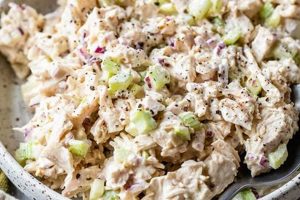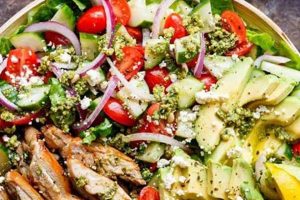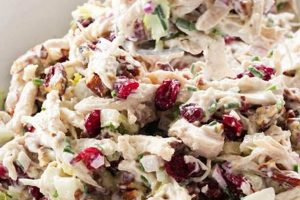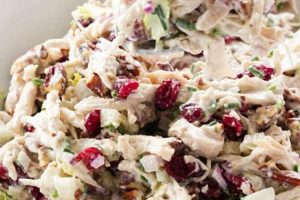A superior chicken salad featuring Greek yogurt as a key ingredient typically involves diced or shredded cooked chicken combined with Greek yogurt, which offers a tangy and healthier alternative to mayonnaise-based recipes. Additional components frequently include chopped celery, onion, grapes, nuts, and seasonings like Dijon mustard, salt, and pepper. Variations can incorporate dried cranberries, apples, or other fruits and vegetables for added flavor and texture.
Utilizing Greek yogurt contributes to a lighter, more protein-rich dish compared to traditional versions. This substitution reduces overall fat and calorie content while increasing nutritional value. The tanginess of Greek yogurt complements the chicken and other ingredients, creating a refreshing and flavorful profile. This approach resonates with contemporary health-conscious consumers seeking flavorful yet nutritious meal options. Historically, chicken salad emerged as a way to utilize leftover cooked chicken, and the incorporation of yogurt reflects a modern adaptation emphasizing healthier ingredients.
This discussion will further explore the nuances of crafting such a dish, including ingredient selection, preparation techniques, and variations to suit individual preferences. Considerations for optimal flavor combinations, storage, and serving suggestions will also be addressed.
Tips for an Exceptional Chicken Salad
Optimizing ingredient selection and preparation techniques elevates chicken salad from simple to exceptional. The following tips offer guidance for crafting a truly superior dish.
Tip 1: Chicken Selection: Opting for high-quality, cooked chicken breast ensures optimal flavor and texture. Roasting or grilling the chicken before shredding or dicing yields a richer, more nuanced flavor profile compared to pre-cooked or boiled chicken.
Tip 2: Greek Yogurt Selection: Plain, non-fat Greek yogurt provides a healthy base while allowing control over seasoning and overall flavor. Full-fat Greek yogurt can be used for a creamier texture, but it increases the calorie and fat content.
Tip 3: Enhancing Flavor Complexity: Incorporating fresh herbs like dill, chives, or parsley adds brightness and depth. A touch of Dijon mustard or lemon juice contributes a welcome tang. Experimenting with spices such as paprika or cumin can introduce intriguing flavor dimensions.
Tip 4: Textural Variety: Adding chopped celery, red onion, or grapes introduces textural contrast and visual appeal. Toasted nuts, such as almonds or walnuts, contribute satisfying crunch.
Tip 5: Balancing Sweetness: Dried cranberries or chopped apples offer a touch of sweetness that balances the savory elements. However, moderation is key to avoid overpowering the other flavors.
Tip 6: Proper Chilling: Allowing the chicken salad to chill for at least 30 minutes in the refrigerator allows the flavors to meld and deepen. This also enhances the overall texture and serving temperature.
Tip 7: Creative Serving Suggestions: While classic sandwich or lettuce wrap presentations are always appealing, consider serving the chicken salad on crackers, cucumber rounds, or endive leaves for elegant variations. It can also be a flavorful filling for avocado halves or bell peppers.
By attending to these details, one can create a chicken salad that is both healthful and delightful, offering a versatile and satisfying meal or snack option.
In conclusion, crafting an exceptional chicken salad featuring Greek yogurt requires careful consideration of ingredients, preparation techniques, and flavor combinations. The provided tips offer guidance for elevating this classic dish to new heights of culinary excellence.
1. High-quality Chicken
High-quality chicken forms the cornerstone of a truly exceptional chicken salad. The chicken’s flavor and texture significantly influence the final dish, underscoring the importance of careful selection and preparation. Subpar chicken can result in a bland or unpleasant salad, regardless of other high-quality ingredients.
- Flavor Profile:
Chicken contributes the dominant flavor to chicken salad. High-quality chicken, such as free-range or organic, offers a richer, cleaner taste compared to conventionally raised chicken. This enhanced flavor profile elevates the overall taste of the salad, allowing other ingredients to complement and enhance it rather than mask any undesirable flavors.
- Texture:
Properly cooked, high-quality chicken provides a desirable, tender texture. Overcooked or dry chicken results in a stringy, less palatable salad. Moist, flavorful chicken absorbs the flavors of the dressing and other ingredients more effectively, creating a cohesive and enjoyable culinary experience.
- Sourcing and Preparation:
The source of the chicken and its preparation method influence both flavor and texture. Roasting or grilling enhances the chicken’s inherent flavor, while boiling can dilute it. Using leftover roasted or grilled chicken offers a convenient and flavorful option for chicken salad. Alternatively, poaching chicken specifically for the salad can provide excellent control over the cooking process and ensure optimal moisture content.
- Overall Impact:
High-quality chicken elevates the perceived quality of the entire dish. The superior taste and texture contribute to a more satisfying sensory experience, making the salad more enjoyable and memorable. When combined with the tangy freshness of Greek yogurt and other carefully selected ingredients, the result is a dish that exemplifies culinary excellence.
Ultimately, selecting high-quality chicken is a non-negotiable aspect of crafting the best chicken salad with Greek yogurt. It establishes the foundation for a flavorful, texturally satisfying dish that showcases the harmonious interplay of carefully chosen ingredients. The difference between using exceptional chicken and a lesser alternative is readily apparent in the final product.
2. Plain Greek Yogurt
Plain Greek yogurt plays a pivotal role in achieving a “best chicken salad with Greek yogurt recipe,” impacting several critical characteristics of the final dish. Its inclusion offers distinct advantages over traditional mayonnaise-based recipes, influencing flavor, texture, and nutritional value. The tangy, slightly acidic nature of plain Greek yogurt provides a refreshing counterpoint to the richness of the chicken, creating a more balanced and complex flavor profile. Unlike mayonnaise, which can mask the subtle flavors of other ingredients, Greek yogurt allows the nuances of herbs, spices, and vegetables to shine through.
The thick, creamy consistency of Greek yogurt contributes significantly to the overall texture of the salad. It provides a cohesive binding agent while maintaining a light and refreshing mouthfeel, avoiding the heavy, sometimes oily texture associated with mayonnaise-based versions. This textural advantage is particularly noticeable when using leaner chicken breast, preventing the salad from becoming dry or crumbly. Consider a scenario where one uses leftover grilled chickenGreek yogurts moisture content helps retain the chicken’s succulence, contributing to a more enjoyable eating experience. Furthermore, the higher protein content of Greek yogurt enhances the nutritional value of the salad. It offers a healthier alternative to mayonnaise, contributing to a greater sense of satiety while minimizing added fat and calories.
Plain Greek yogurt offers a versatile foundation for flavor customization. Its neutral taste profile serves as a blank canvas, allowing for a wide range of flavor combinations. From classic pairings like dill and lemon juice to more adventurous additions like curry powder or roasted red peppers, the possibilities are vast. This adaptability enables customization to cater to individual preferences and dietary restrictions, further solidifying its position as a key ingredient in the “best chicken salad with Greek yogurt recipe.” The selection of plain Greek yogurt also provides control over the level of tanginess and sweetness in the final product, ensuring a balanced and harmonious flavor profile. This control is crucial for achieving the desired balance and avoiding an overly acidic or sweet result. The subtle tang of Greek yogurt enhances the savory notes of the chicken and other ingredients, creating a more dynamic and flavorful salad.
3. Fresh Herbs and Spices
Fresh herbs and spices constitute a critical element in elevating a chicken salad featuring Greek yogurt from palatable to exceptional. They contribute layers of flavor complexity and aromatic depth, transforming the dish from simple to sophisticated. The inherent tanginess of Greek yogurt provides a receptive backdrop for the bright, herbaceous notes of fresh herbs, allowing their individual characteristics to shine. Dill, for instance, offers a subtle anise-like flavor that complements the richness of the chicken, while chives contribute a delicate oniony nuance. Parsley introduces a fresh, slightly peppery element, while mint can add a refreshing, cooling counterpoint. The selection of herbs should be guided by personal preference and the overall flavor profile desired.
Spices, used judiciously, further enhance the complexity of the chicken salad. A pinch of smoked paprika can introduce a subtle smoky depth, while cumin adds a warm, earthy note. A touch of cayenne pepper provides a gentle heat, balancing the creamy richness of the yogurt and chicken. The interplay between fresh herbs and complementary spices creates a dynamic flavor profile that elevates the chicken salad beyond the ordinary. Consider a scenario where freshly chopped dill, chives, and a pinch of smoked paprika are incorporated into the salad. The dill and chives provide a bright, herbaceous counterpoint to the richness of the chicken and the tang of the yogurt, while the smoked paprika introduces a subtle smoky depth. This combination creates a more nuanced and engaging flavor experience.
The use of fresh herbs and spices in a Greek yogurt-based chicken salad offers significant practical advantages. These ingredients not only enhance flavor but also contribute to a healthier profile compared to relying solely on salt or processed seasonings. Fresh herbs and spices are rich in antioxidants and other beneficial compounds, aligning with the health-conscious nature of using Greek yogurt as a base. Careful selection and balanced incorporation of fresh herbs and spices are crucial for achieving optimal results. Overuse can overwhelm the delicate flavors of the chicken and yogurt, while insufficient quantities may fail to impart the desired complexity. A thoughtful approach, guided by experimentation and personal preference, allows for the creation of a truly exceptional chicken salad that exemplifies the synergistic potential of fresh, high-quality ingredients.
4. Textural Elements
Textural elements play a crucial role in a superior chicken salad incorporating Greek yogurt. A harmonious blend of textures elevates the sensory experience beyond mere flavor, creating a more engaging and satisfying culinary experience. The creamy base provided by the Greek yogurt offers a foundation upon which a variety of contrasting textures can be built, resulting in a dynamic interplay that delights the palate.
- Crunchy Elements:
Incorporating crunchy elements provides a stark contrast to the creamy yogurt base. Common choices include chopped celery, diced red onion, or slivered almonds. These additions introduce a satisfying snap or crunch, preventing the salad from becoming monotonous. The interplay between creamy and crunchy textures creates a more dynamic and enjoyable eating experience.
- Soft Elements:
While crunch provides contrast, soft elements contribute to overall balance. Grapes, dried cranberries, or chopped apples offer pockets of sweetness and a yielding texture that complements the creaminess of the yogurt and the tenderness of the chicken. These additions prevent the salad from becoming overly crunchy, ensuring a harmonious blend of textures.
- Chicken Texture:
The texture of the chicken itself significantly impacts the final product. Shredded chicken creates a finer, more integrated texture, while diced chicken offers more substantial, distinct pieces. The choice depends on personal preference and the desired overall texture of the salad. Overcooked, dry chicken can negatively impact the salad, highlighting the importance of properly cooked, moist chicken.
- Balancing Textures:
Achieving textural balance is essential. Too much crunch can be overwhelming, while an absence of contrasting textures can result in a bland, monotonous experience. The ideal chicken salad features a harmonious interplay of creamy, crunchy, and soft elements, creating a multi-dimensional textural experience that enhances enjoyment.
The strategic incorporation of various textural elements elevates a Greek yogurt chicken salad from simple to exceptional. The interplay of these textures creates a more engaging and satisfying culinary experience, transforming a basic chicken salad into a dish that delights the senses.
5. Balanced Flavors
Balanced flavors are essential to achieving a truly exceptional chicken salad with Greek yogurt. This balance refers to the harmonious interplay of sweet, savory, tangy, and acidic notes, resulting in a complex and nuanced flavor profile that avoids extremes. The inherent tanginess of Greek yogurt provides a foundation for this balance, offering a slightly acidic counterpoint to the richness of the chicken. Without careful consideration of flavor balance, the salad can become overly sweet, excessively tangy, or bland and uninspired.
Consider the interplay of ingredients in a well-balanced chicken salad. The savory notes of the chicken are complemented by the tangy yogurt, creating a foundation of balanced flavors. Adding a touch of sweetness, such as from dried cranberries or chopped grapes, further enhances this complexity. A hint of acidity from lemon juice or apple cider vinegar brightens the flavors, while fresh herbs like dill or chives provide an aromatic lift. A well-balanced chicken salad avoids relying too heavily on any single flavor, allowing the nuances of each ingredient to shine through.
The practical significance of flavor balance is readily apparent in the final product. A chicken salad with balanced flavors is more enjoyable and satisfying than one dominated by a single flavor note. This balance prevents palate fatigue and allows for appreciation of the individual components of the salad. Furthermore, balanced flavors enhance versatility, allowing the salad to be paired with a wider variety of accompaniments, from crackers and bread to salads and wraps. A chicken salad that lacks balance may be enjoyable in small quantities but quickly becomes overwhelming or monotonous.
6. Proper Chilling Time
Proper chilling time is integral to achieving the “best chicken salad with Greek yogurt recipe.” This seemingly simple step significantly influences the final product’s flavor, texture, and overall quality. Chilling allows the diverse flavors of the ingredients to meld and harmonize, creating a more cohesive and nuanced taste profile.
- Flavor Development:
Chilling allows the flavors of the various ingredientschicken, Greek yogurt, herbs, spices, and textural additionsto meld and mature. This fusion creates a more complex and balanced flavor profile than immediately after preparation. The chilling process allows the ingredients to “marry,” resulting in a more harmonious and nuanced taste. Similar to marinating meat, the waiting period allows deeper flavor penetration and complexity.
- Texture Enhancement:
Chilling firms the Greek yogurt base, enhancing the salad’s overall texture. This firming prevents the salad from becoming watery or runny, particularly when using add-ins like grapes or celery. The chilling process also allows the textural elements to absorb some of the dressing’s flavors, creating a more cohesive and enjoyable textural experience. This chilling and firming process can be compared to the setting of certain desserts, where a waiting period improves consistency and texture.
- Food Safety:
Chilling is crucial for food safety, especially with perishable ingredients like chicken and yogurt. Proper refrigeration inhibits bacterial growth, ensuring the salad remains safe for consumption. Maintaining a safe temperature throughout the preparation and chilling process is paramount for preventing foodborne illnesses. Guidelines for safe food handling should always be followed. This mirrors the principles of safe food handling applied to other dishes containing perishable ingredients.
- Optimal Serving Temperature:
A chilled chicken salad offers a more refreshing and palatable dining experience, especially in warmer weather. The cool temperature enhances the perception of freshness and complements the tangy flavors of the yogurt and other ingredients. Serving the salad chilled optimizes its sensory qualities, making it more enjoyable to consume. This is analogous to serving other dishes like gazpacho or chilled soups, where the temperature enhances the overall experience.
Therefore, proper chilling time is not merely a procedural afterthought but a crucial step in crafting the “best chicken salad with Greek yogurt recipe.” It contributes significantly to flavor development, texture enhancement, and food safety, ultimately elevating the dish from a simple mixture of ingredients to a cohesive and delightful culinary creation. Neglecting this step compromises the quality and enjoyment of the final product.
Frequently Asked Questions
This section addresses common inquiries regarding the preparation and enjoyment of chicken salad made with Greek yogurt.
Question 1: What type of Greek yogurt is best suited for chicken salad?
Plain, non-fat Greek yogurt is generally recommended. It provides a balanced tang without excessive richness and allows for greater control over seasoning. Full-fat Greek yogurt can be used for a creamier texture, but it will increase the calorie and fat content.
Question 2: Can the recipe be adapted for specific dietary needs?
The recipe is highly adaptable. For gluten-free diets, ensure all additional ingredients, such as crackers or bread for serving, are gluten-free. For dairy-free versions, consider substituting a dairy-free yogurt alternative, but be mindful of potential texture and flavor variations.
Question 3: How long can chicken salad with Greek yogurt be stored?
When stored properly in an airtight container in the refrigerator, chicken salad with Greek yogurt typically lasts for three to five days. Always check for spoilage before consuming.
Question 4: What are the best methods for preventing the salad from becoming watery?
Using a thicker Greek yogurt and ensuring all ingredients, especially vegetables, are thoroughly drained before incorporation can help prevent excess moisture. Chilling the salad for at least 30 minutes before serving also allows the yogurt to firm up and absorb excess liquid.
Question 5: Can other ingredients be added besides the typical celery, onion, and grapes?
The recipe is highly versatile. Additions such as dried cranberries, chopped apples, walnuts, pecans, or water chestnuts can enhance flavor and texture. Experimentation is encouraged to discover preferred flavor combinations.
Question 6: Is it possible to freeze chicken salad made with Greek yogurt?
Freezing is generally not recommended. Freezing can negatively affect the texture of both the chicken and the yogurt, resulting in a watery and less palatable salad upon thawing. It’s best to prepare and consume the chicken salad within the recommended refrigeration timeframe.
Understanding these frequently asked questions facilitates the successful preparation and enjoyment of chicken salad featuring Greek yogurt. Careful consideration of ingredient selection, preparation techniques, and storage practices ensures optimal results.
The following sections will offer specific recipe variations and serving suggestions to further enhance the culinary experience.
Best Chicken Salad with Greek Yogurt Recipe
Exploration of the “best chicken salad with Greek yogurt recipe” reveals that achieving culinary excellence requires careful attention to several key elements. High-quality chicken, plain Greek yogurt, fresh herbs and spices, balanced textures, harmonious flavors, and adequate chilling time contribute synergistically to a superior final product. Ingredient selection and preparation techniques significantly influence the overall taste, texture, and nutritional value. Understanding the interplay of these factors empowers culinary enthusiasts to create a dish that transcends the ordinary.
The “best chicken salad with Greek yogurt recipe” represents more than a simple list of ingredients and instructions. It embodies a culinary philosophy that prioritizes fresh, wholesome ingredients and thoughtful preparation. This approach yields a dish that is not only flavorful and satisfying but also nutritionally sound. Further exploration of flavor profiles, textural variations, and presentation styles promises continued culinary innovation within this classic dish.






